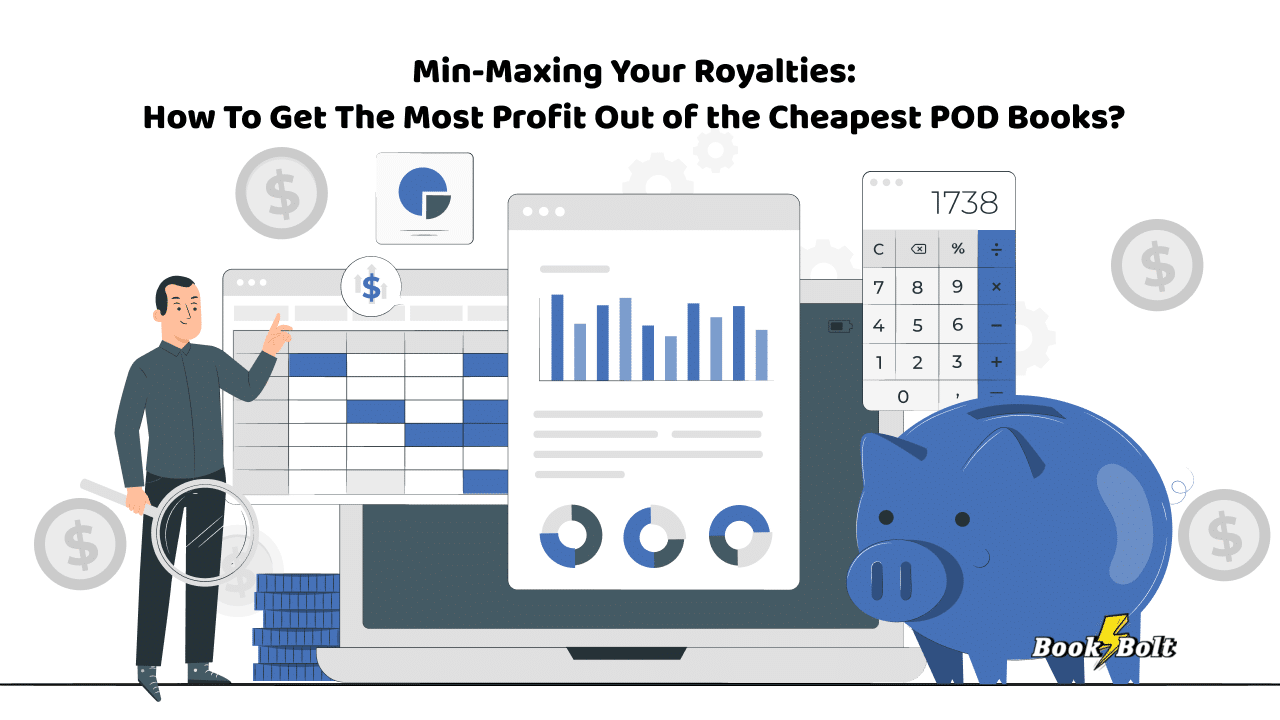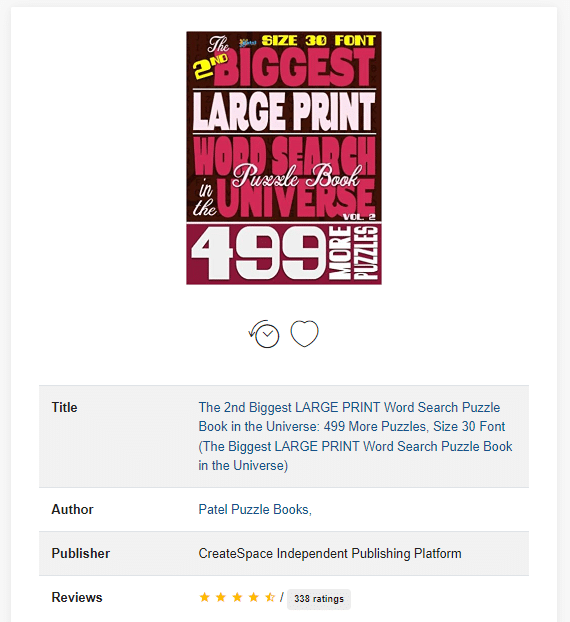
In the ever-evolving landscape of self-publishing, authors are constantly seeking innovative ways to make their mark in the low- and no-content book space. And while POD books offer convenience, the question of maximizing profits often remains unanswered.
Can you earn satisfactory profits and offer competitive pricing at the same time? Below, we answer this question by exploring the type of royalties some of the most affordable listings in the no- and low-content book categories make.
The prices that make your listings eligible for royalties
It’s a common assumption that all sellers earn royalties from Amazon sales. However, the reality is much different. There are, indeed, certain products that generate sales, yet don’t yield royalties for the seller.
In the POD book space, these listings are those priced under $3 and sometimes under $4. Let’s find out why.
Calculating low- and no-content book royalties
When we first started analyzing the most affordable puzzle books, activity books, journals, and other book formats, we noticed that a lot of items were priced at $3.42, $2.17, or even $2.05. As it turns out, these listings make zero profits for the seller.
Here’s why.
KDP rewards book creators with a fixed 60% royalty rate of the list price on paperbacks. However, to calculate the exact royalty to be earned, you must subtract printing costs. These costs depend on page count, ink type, and the Amazon marketplace that you’re selling in.
In short, here’s the formula you need to use:
(Royalty rate x list price) – printing costs = royalty, where printing cost = Fixed cost + (page count * per page cost)
The exact details on fixed costs and per-page costs can be found on Amazon’s website.
For instance, for a 333-page paperback with black ink sold on the US marketplace for $15, the royalties per sale would be:
(0.60 x $15) – $4.85 = $4.15
But if we calculate the royalties per sale for a $2.17 paperback book of 25 pages, we establish that they would equal $0.
For this reason, we decided to perform our research into the lowest-priced listings using a minimum price of $4. This would enable us to compare royalties adequately and offer some valuable conclusions for sellers looking to maximize earnings.
Top-performing categories included in our research
The Amazon KDP space is well-developed and diverse. Sellers can choose from a wide array of low- and no-content book categories to sell in.
However, we’ve identified the following five categories that are most popular among shoppers and generate the highest sales volumes:
- Activity books
- Journals
- Puzzle books
- Notebooks
- Coloring books
Let’s uncover the most inexpensive products from each category and their royalties per sale. We’ll also calculate the monthly royalties the listings earn based on their estimated sales per month.
We’ve organized our findings starting with the book categories that are least profitable in terms of cheapest items to most profitable.
Activity books
Using the $4 minimum we explained above, we detected that the lowest-priced listing is the “German Word Search Puzzles Book: 100 Large Print German Word Search Puzzle Book | Learn German Language Vocabulary With Challenging Word Find Puzzles … And Women | Stress Relieving Activity Book”, which costs $4.01. It’s a 129-page product that has a BSR of 238,942.
Using the formula we mentioned above, this listing generates royalties of $0.01 per sale. With an estimated monthly sales volume of 152 sales, the expected profit per month is only $1.52.
Naturally, this number is far from attractive for most low- or no-content book creators. However, keep in mind that such listings can also be valuable. Considering that they secure enough sales, they can be used as stepping stones to boost popularity and build trust among consumers.
Journals
Journals are another category that creates waves among Amazon users. Here, the cheapest product for sale over $4 is the “Define Your Dreams: A Grace-Filled Guide to Dreaming with God (Guided Journal)”, which sells for $4.06. It’s 120 pages long and has a BSR of 2,318,482, generating around 1 sale per month.
Based on our calculations, this low-content book rewards the seller with $0.15 for every sale. On a monthly basis, this results in roughly $0.15 of profit (given that the estimated monthly sales are 1).
You’ll notice that while still low, the royalties are much higher than our previous example in the activity book space. Why? Because the book length is much shorter here.
Our research helped us conclude that shorter books (in most categories) provide higher royalties per sale. We’ll prove this in the sections to come.
Puzzle books
Next up, we landed on a very short and low-cost puzzle book – the “The 2nd Biggest LARGE PRINT Word Search Puzzle Book in the Universe (Book 3): 500 Puzzles” listing. In contrast to the majority of puzzle books, which feature hundreds of pages, this product only contains 60 pages of puzzle activities.
It sells for $4.11 and records only around 38 sales per month. At the same time, it yields more royalties on a monthly basis than the previous two examples.
Working out the numbers, we found out that the royalty per sale is $0.32, equating to $19.20 of monthly profits for the seller. This exceeds both the monthly royalties for the cheapest journal ($12.06) and the cheapest activity book ($1.52).
This high royalty potential could be influenced by the length of the book (only 60 pages, proving our theory from above). It could also indicate that as a seller, you could get away with more returns for a shorter product.
It’s also worth noting that puzzle books are usually very easy to create, especially if you use sophisticated tools like Book Bolt’s puzzle book designer.
Notebooks
Data suggests that notebooks are the category with the second-highest monthly royalty potential for the most affordable listing.
With a price tag of $4.19, the “Sketchbook for Girls: Artist Pad Paper| Sketchbook Drawing Painting| Artistic Notebook| Drawing Pad Kids Large|Notepad Drawing|Drawing Pads for Kids 9-12” listing offers 128 pages. It secures around 227 sales per month and has a BSR of 107,411.
Doing the math, we discovered that the royalty per sale, in this case, is $0.13. This is less than the per-sale royalty of the cheapest puzzle book ($0.32). However, the monthly profit is much higher ($29.51) due to the sales volume.
Notebooks are one of the most trendy low-content book niches, guaranteeing a lot of sales potential. They’re also quick to create as in most cases, their interior is blank and simple, even for beginners.
Having all of this in mind, this is one of the categories we’d recommend entering if you’re looking to min-max your royalties.
Coloring books
Finally, coloring books stand out with the most substantial monthly earnings when compared to the rest of the niches in this article.
The most inexpensive listing in the space is “FACIAL ANATOMY: Colouring book”, which sells for $4.01. This item lands around 255 sales per month and consists of 55 pages. Its BSR is much lower than most others (60,550), making the product a success story in the low- and no-content book market.
Our calculations reveal that the per-sale royalties are $0.26, while the monthly royalties the seller earns are around $66.30. As you can see, this is also one of the shortest books on this list, explaining the higher earnings potential.
Putting numbers into valuable insights
Digging deeper into some of the most affordable listings on Amazon KDP enables us to identify the categories that provide the highest money-making potential and still guarantee a competitive edge.
For new entrants into a niche, positioning your items as affordable as possible is key. This will boost your attractiveness and will help you stand out from the crowd. But as research shows, this is not always an efficient strategy in all categories.
Based on our findings, you can maximize your royalties by keeping your low- or no-content books shorter. From the examined listings, we concluded that puzzle books generate the most lucrative royalties per sale, while coloring books secure the highest monthly earnings.
Conclusion
When determining your next move on Amazon KDP, it’s key to make informed and data-driven decisions. The insights from above can help you tap into new low- or no-content book categories with a low listing price and still earn a financial reward. However, don’t forget that research is vital. Use Book Bolt to your advantage and gain the advantage other sellers dream of.



